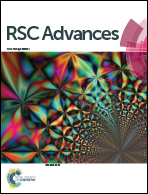Effects of an additive (hydroxyapatite–bentonite–biochar) on Cd and Pb stabilization and microbial community composition in contaminated vegetable soil†
Abstract
A two-year pot experiment was conducted with a pimiento–celery cabbage (Capsicum annuum L.–Brassica pekinensis) rotation in acidic soil contaminated with Cd and Pb, which was amended with 0.0, 1.0, 2.5, 5.0 and 10.0% (w/w) premixtures of hydroxyapatite, bentonite and biochar combinations (HTB, in a ratio of 1 : 2 : 2). The results showed that the application of HTB at 2.5–10.0% significantly increased soil pH and organic carbon by an average of 10.38–17.60% and 35.60–55.34% during the two years, respectively. Compared to the control treatment, 1.0–10.0% HTB decreased the available Cd and Pb concentrations by 40.92–77.53% and 41.60–82.79% on average, respectively. In addition, the diversity and richness of the soil bacterial community improved after the two-year application of HTB. The relative abundances of Acidobacteria, Bacteroidetes and Chloroflexi increased under the HTB treatments, while those of Proteobacteria and Actinobacteria decreased. Redundancy analysis (RDA) and regression analysis indicated that soil pH and Cd and Pb availability were important factors shaping the soil bacterial community. The Cd and Pb concentrations in the edible parts of pimiento and celery cabbage decreased as the HTB application rate increased and met the Food Quality Standard in each season when the HTB application rate was 5.0% or higher. Higher rates of HTB (5.0% and 10.0%) not only ensured the quality of vegetables, but also significantly promoted pimiento and celery cabbage growth. Overall, these results indicated that the application of HTB, especially at a rate of 5.0%, could be an effective way to immobilize Cd and Pb, improve soil quality and ensure vegetables produced in acidic contaminated soil are safe for human consumption.



 Please wait while we load your content...
Please wait while we load your content...